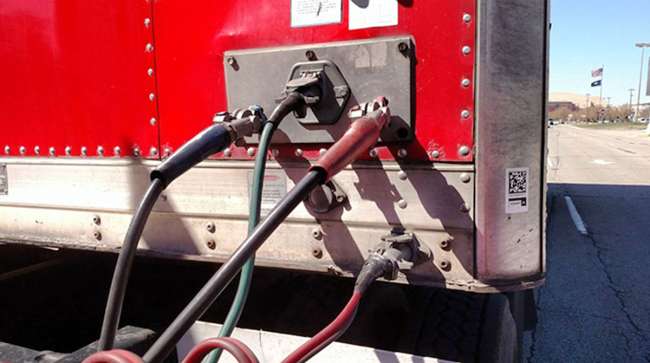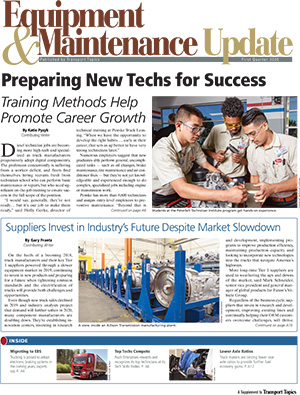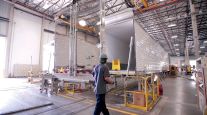Tractor-Trailers at a Tipping Point

[Stay on top of transportation news: Get TTNews in your inbox.]
Sometimes a seemingly innocuous incident can signal that profound changes are looming on the horizon. Remember when the cruise ship just meandered into that little wave in The Poseidon Adventure? As the trucking industry and government regulators both seek to take advantage of productivity, safety and maintenance-enhancing opportunities presented by wave after wave of new technologies available or under development, in both power units and trailers, are we about to encounter a wave that cannot be met with the existing tractor-trailer power and communications architecture?
ATA’s Technology & Maintenance Council and SAE International will be pooling their expertise and leadership as the preeminent developers, respectively, of specification engineering and maintenance practices and design engineering standards for commercial vehicles, at the upcoming TMC 2020 Annual Meeting & Transportation Technology Exhibition, Feb. 24-27 at the Georgia World Congress Center in Atlanta. The confluence of a number of technical events and needs assessment has led to the development of the third annual TMC/SAE Symposium, “The Combination Vehicle as a Connected Whole,” which will dive into tractor-trailer connectivity, communications and integrated systems.
It took decades for the industry to settle upon a standardized connection for power and signaling in the tractor-to-trailer hookup, and virtually all of the millions of commonly specified tractors, trailers, intermodal chassis and converter dollies used in the North American market can be interchangeably mated in various combinations. It is this standardization that facilitates maintenance facilities that can readily perform maintenance and repairs on commercial vehicles thousands of miles from their home terminals, and facilitates the mergers, acquisitions and divestitures of fleets, as well as enables independent owner-operator and secondary market segments.
You can invite fleet colleagues to come back to the TMC 2020 Annual Meeting! Returning attendees can receive a $100 discount off of their full TMC 2020 Annual Meeting registration. Use promo code TMC20FLEET to save! #TMCAnnual20 pic.twitter.com/CVBTYjJWpD — Technology & Maintenance Council (TMC) of ATA (@TMC4Trucks) January 10, 2020
A number of unrelated occurrences have illustrated that while it may be simple to address the design and implementation of a new technology solution to an identified need, it is the effect of any single component upon the increasing complexity of today’s combinations that is creating pause to assess whether we have hit the upper limit of what can be done with the “legacy” connection system.
A prime example is a recent, simple request from fleets and operators in the Ontario Province to allow for a switch to be added to cab controls to allow emergency pickup of pusher and tag axles of trucks and trailers while activating the vehicle emergency flashers for the brief time the axles are up.
However, this seemingly simple-to-conceive feature affects both the tractor and trailer, the CAN bus, the ABS controller, the air system, the lighting controls and signal lines, the priorities in the transmission of command signals in the hierarchy of data flowing through the multiplex pins on the tractor-trailer coupling, and so on.
When brought to the engineering level, things are not so simple — to the point that it may not be solvable on the current 7-pin connector/cable.
Is this illustrative of a tipping point issue that drives adoption of the 13-pin connector and new data handling protocols? In addition, what does this mean for existing trailers, of mixed fleets of new and old tech? This and many needs can easily be solved in isolation, but when combined with all of the other technology opportunities being presented to the industry or on the drawing board, will the technical limits of the connection significantly inhibit the introduction of new technology and integrated safety systems? Will the competition for power or data bandwidth compromise the necessity for virtually flawless command circuits for higher levels of advanced driver assistance systems (ADAS) and automated driving systems?
Paul Menig, CEO of Business Accelerants, chairs two new task forces approved at the recent TMC Fall Meeting in Raleigh, N.C.: Study Group S.1’s (Electrical) Next Generation Tractor-Trailer Electrical Interface Task Force and S.7’s (Trailers, Bodies & Material Handling) Next Generation Trailer Electrical Architecture Task Force. Both of these task forces will conduct their first meetings on Feb. 24 in Atlanta.

- Preparing New Technicians for Service
- Electronic Braking Systems Expected to Gain Traction
- Suppliers Invest in Industry's Future Despite Market Slowdown
- Technician Career Development: An Endless Journey
- LEDs Represent Future of Truck Headlamps
- Rear-Axle Ratios Are Still Moving Downward
- Tractor-Trailers at a Tipping Point
Menig states, “We are absolutely at a critical junction (all pun intended) in our industry. Trailer telematics are now used on almost 25% of all trailers. OEMs are focusing on significant safety and productivity improvements to SAE Level 2 operation of combination vehicles while working toward SAE Level 4 operation before 2030. The current tractor-trailer junction consisting of seven on-off electrical signals, one questionable, low-speed data signal, and two on-off pneumatic signals is woefully inadequate to support where the industry is headed. As an industry, we will see an increasing number of computers and sensors applied to the trailer, just as we have over the last three decades on the tractor. Standards across all trailers and tractors are a necessity. According to a recent survey, 84% of fleets run trailers from more than one manufacturer and 53% of fleets lease/rent trailers.”
The survey that Menig refers to is part of a white paper, “Smart Trailer Data: An Untapped Resource,” produced by TMC member Spireon, Inc., of Irvine, Calif., which also points out that while fleets are operating a significant number of smart trailers, less than 40% are actually utilizing the trailer telematic data that is being generated. TMC’s various study groups and its Future Truck Committee are continually seeking to develop consensus practices that the industry can use to improve maintenance reliability and even use telematics to implement predictive maintenance programs to avoid on-road failures. Critical to this is the reliable and efficient communication of data packages from the trailer’s sensor array with the tractor’s communications portal.
Wally Stegall, technical fellow and director with The Morey Corporation, is chairman of the TMC Future Truck Committee’s Sensor Enhanced Maintenance Task Force, which is looking at the potential performance specifications for a new type of “data gateway” nose box for a trailer that may provide for backward compatibility of older trailers with new generations of power units and of advanced-technology-equipped tractors with trailers that may remain in service for two or even three decades. Stegall sees that with such a gateway the power line carrier (PLC) signal would simply work as it does today, allowing for reverse compatibility with older tractors or older trailers.
In part one of a two-part exploration of autonomous technology today, our latest RoadSigns podcast revisits conversations with CEOs Alex Rodrigues of Embark and Cetin Mericli of Locomation. Hear them explain what testing automated trucks and developing platooning technology has taught them about the road ahead — and get new perspective with host commentary. Listen to a snippet from Rodrigues above, and to hear the full episode, go to RoadSigns.TTNews.com.
Dave Engelbert, chief engineer with Haldex Brake Products Corp., is working with TMC’s Future Chassis & Brake Task Force to develop a position paper regarding the criteria that need to be considered for the development of automated tractor-trailer coupling systems, which also would have the benefit of advising the drivers of less-than-highly-automated combinations of the trailer status.
These types of data packaging solutions would also facilitate communications of the combination vehicle with the evolving intelligent highway system and with the law enforcement/regulatory community charged with safety oversight of commercial vehicle operations.
He also points out that the advent of high voltage electric trucks, hybrids, solar power, trailer drive axles with regenerative power and supplemental propulsion, electric trailer refrigeration units, and ever-increasing telematics power needs are introducing multivoltage electric power systems across the medium- and heavy-duty spectrum. These will need to be addressed in terms of forward and backward compatibility.
TMC’s current research in partnership with FPInnovations PIT Group into the potential for electromechanical braking systems is also polling OEMs and suppliers regarding the limitations that the current 12-volt power and data connections may present to the ability of these types of technologies to meet or exceed traditional pneumatic braking systems. The potential benefits of having logic controllers at the wheel ends are predicated upon having flawless and fail-safe data command signals to the individual controllers. TMC will be reporting the findings of this research in Atlanta.
The third annual TMC/SAE Symposium, scheduled for Feb. 24, will challenge fleets to become strategically focused on the interconnected Automated, Connected, Electric and Safety future for combination vehicles used in North American trucking. For more information, see tmcannual.trucking.org.
Want more news? Listen to today's daily briefing:





